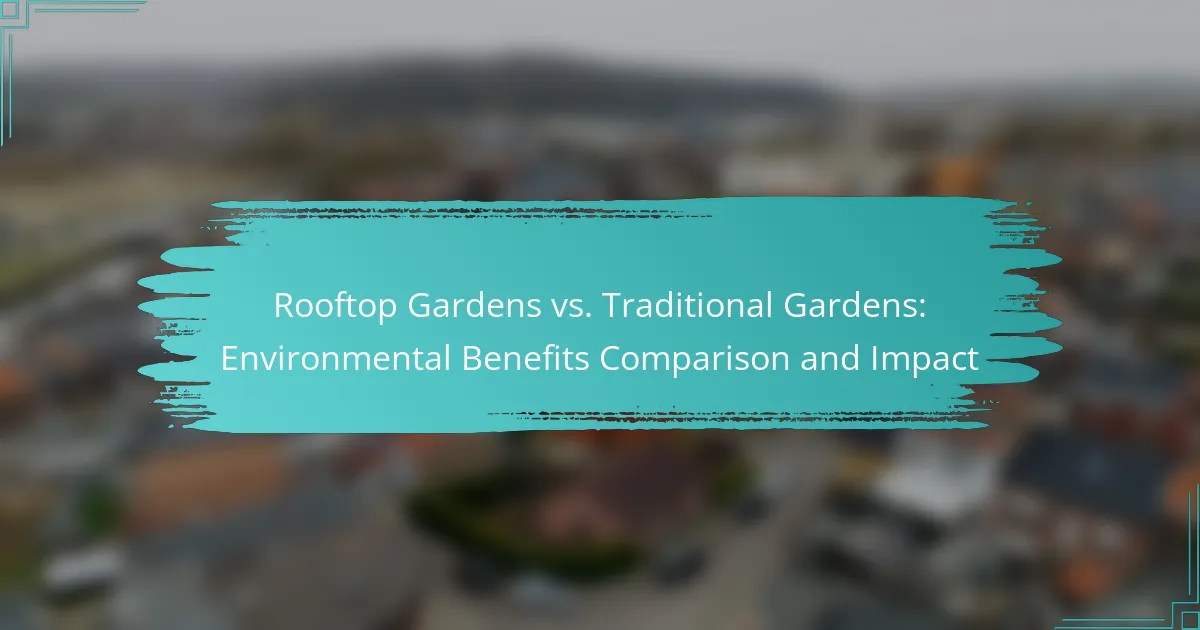Rooftop gardens and traditional gardens each offer unique environmental benefits that contribute to sustainability. Rooftop gardens excel in urban areas by reducing heat, improving air quality, and managing stormwater, while traditional gardens enhance soil health and support local wildlife. Together, they play crucial roles in fostering healthier ecosystems and promoting environmental resilience.
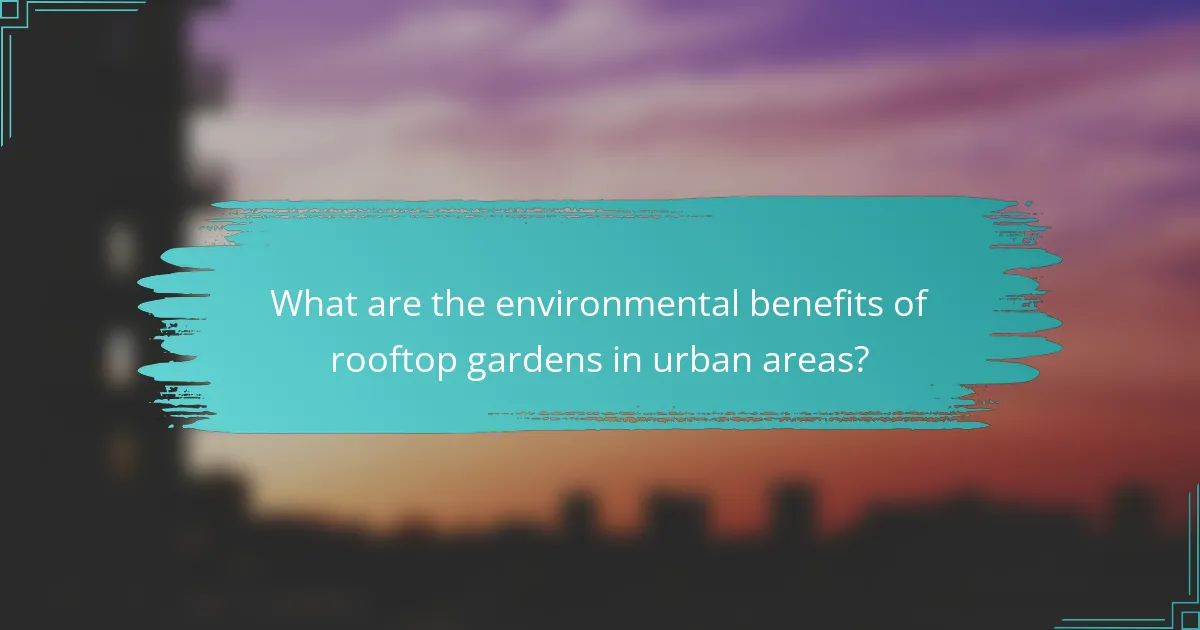
What are the environmental benefits of rooftop gardens in urban areas?
Rooftop gardens provide significant environmental advantages in urban settings by mitigating heat, improving air quality, managing stormwater, enhancing biodiversity, and increasing energy efficiency in buildings. These benefits contribute to healthier urban ecosystems and improved living conditions for residents.
Reduction of urban heat island effect
Rooftop gardens help combat the urban heat island effect by absorbing sunlight and reducing surface temperatures. Traditional urban areas often experience higher temperatures due to concrete and asphalt, but green roofs can lower these temperatures by several degrees, creating a more comfortable environment.
Implementing rooftop gardens can lead to cooler neighborhoods, which can reduce energy consumption for air conditioning. This is especially beneficial during hot summer months, where temperature differences can be significant.
Improved air quality
Rooftop gardens contribute to improved air quality by filtering pollutants and absorbing carbon dioxide. Plants naturally take in harmful gases and release oxygen, which enhances the overall air quality in densely populated urban areas.
Incorporating a variety of plants can maximize these benefits, as different species have unique abilities to capture specific pollutants. This makes rooftop gardens a valuable asset for cities aiming to meet air quality standards and improve public health.
Stormwater management
Rooftop gardens play a crucial role in stormwater management by absorbing rainwater and reducing runoff. This helps prevent flooding and decreases the burden on urban drainage systems during heavy rainfall.
By retaining water, these gardens can also filter pollutants before they enter the stormwater system, contributing to cleaner waterways. This is particularly important in cities where stormwater pollution is a significant environmental concern.
Increased biodiversity
Rooftop gardens can enhance urban biodiversity by providing habitats for various species, including birds, insects, and other wildlife. These green spaces create essential ecosystems that support pollinators and other beneficial organisms.
Designing rooftop gardens with native plants can further promote biodiversity, as these species are well-adapted to local conditions and can thrive with minimal maintenance. This approach fosters a more resilient urban ecosystem.
Energy efficiency in buildings
Rooftop gardens improve energy efficiency in buildings by providing insulation, which can lower heating and cooling costs. The vegetation acts as a barrier against heat loss in winter and heat gain in summer, leading to more stable indoor temperatures.
Studies suggest that buildings with green roofs can experience energy savings of 20-30% compared to those without. This not only reduces utility bills but also lessens the overall demand for energy in urban areas, contributing to sustainability efforts.
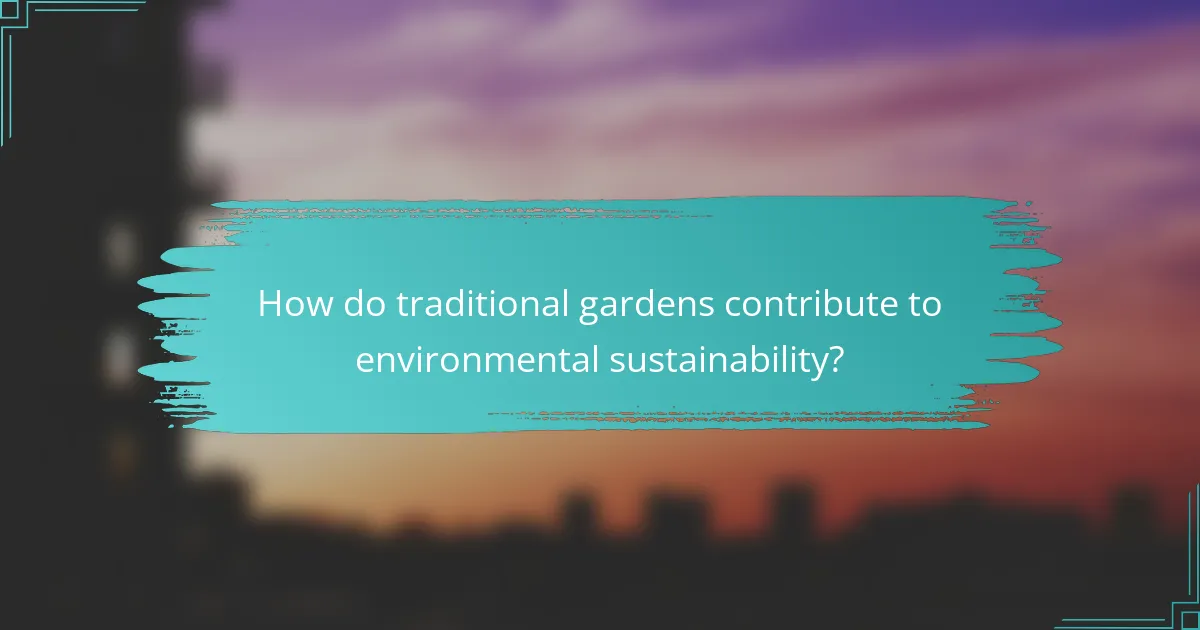
How do traditional gardens contribute to environmental sustainability?
Traditional gardens play a significant role in environmental sustainability by enhancing soil health, sequestering carbon, supporting local wildlife, and promoting water conservation. These gardens create ecosystems that benefit both the environment and the community.
Soil health improvement
Traditional gardens enhance soil health by increasing organic matter and promoting biodiversity. The addition of compost, mulch, and diverse plant species helps to improve soil structure, fertility, and microbial activity.
Practices such as crop rotation and cover cropping can further enrich the soil, reducing the need for chemical fertilizers. This not only supports plant growth but also minimizes nutrient runoff into nearby waterways.
Carbon sequestration
Traditional gardens contribute to carbon sequestration by capturing carbon dioxide from the atmosphere through photosynthesis. Plants store carbon in their biomass and in the soil, helping to mitigate climate change.
Incorporating perennial plants and trees into gardens can enhance this effect, as they store carbon for longer periods compared to annual crops. Even small gardens can make a difference by sequestering several kilograms of carbon annually.
Support for local wildlife
Traditional gardens provide essential habitats for local wildlife, including pollinators, birds, and beneficial insects. By planting native species and creating diverse plant communities, gardeners can attract and sustain these important organisms.
Incorporating features like water sources, nesting sites, and shelter can further enhance biodiversity. This not only supports wildlife but also promotes healthier ecosystems and improved pollination for food crops.
Water conservation practices
Traditional gardens can implement effective water conservation practices that reduce overall water usage. Techniques such as mulching, drip irrigation, and rainwater harvesting help to retain moisture in the soil and minimize waste.
Using drought-resistant plants and grouping plants with similar water needs can further optimize water use. These practices are especially beneficial in regions facing water scarcity, allowing gardens to thrive while conserving precious resources.
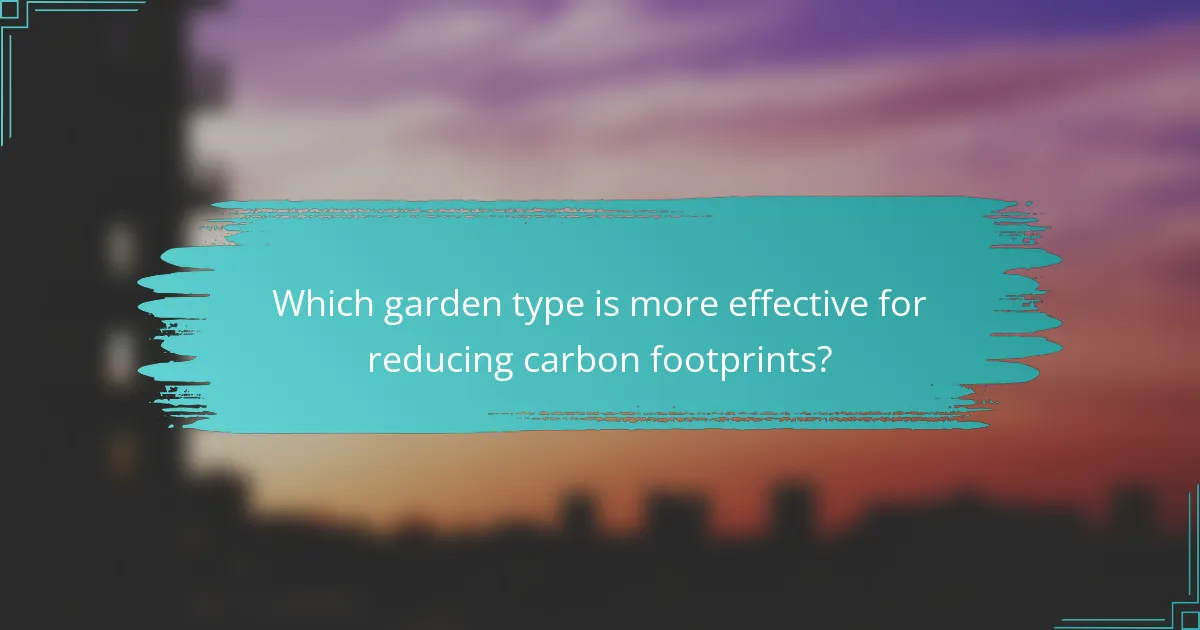
Which garden type is more effective for reducing carbon footprints?
Rooftop gardens are generally more effective at reducing carbon footprints in urban areas due to their ability to absorb CO2 and mitigate heat island effects. However, traditional gardens also contribute significantly to carbon storage over time, making both types valuable in different contexts.
Rooftop gardens’ carbon offset potential
Rooftop gardens can significantly offset carbon emissions by capturing CO2 through photosynthesis and providing insulation for buildings. This insulation reduces the need for heating and cooling, leading to lower energy consumption and greenhouse gas emissions.
Additionally, these gardens can help manage stormwater runoff, which reduces the burden on urban drainage systems. By retaining rainwater, rooftop gardens can decrease the likelihood of flooding and improve water quality in surrounding areas.
Traditional gardens’ long-term carbon storage
Traditional gardens contribute to long-term carbon storage by sequestering carbon in soil and plant biomass. Over time, healthy soil can store substantial amounts of carbon, making these gardens effective in combating climate change.
Moreover, traditional gardens support biodiversity, which enhances ecosystem resilience. By planting a variety of species, gardeners can create habitats that promote healthy soil and improve carbon sequestration capabilities.
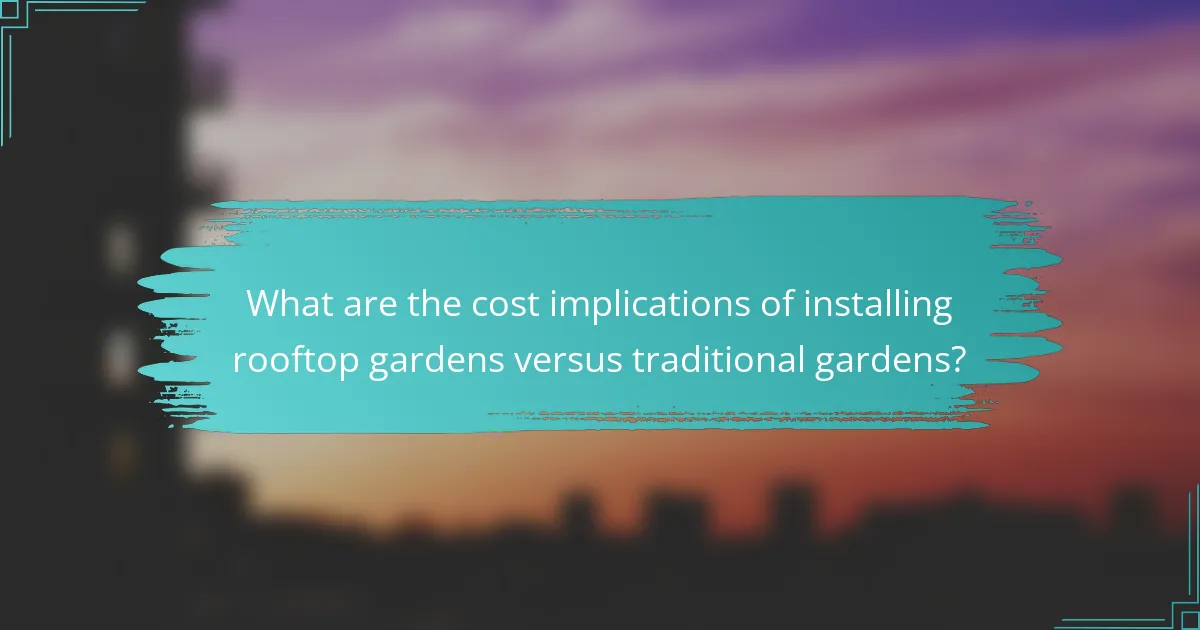
What are the cost implications of installing rooftop gardens versus traditional gardens?
Rooftop gardens typically involve higher initial costs compared to traditional gardens, but they can lead to significant long-term savings. Factors such as installation, maintenance, and energy efficiency play crucial roles in determining the overall financial impact.
Initial installation costs of rooftop gardens
The initial installation costs for rooftop gardens can be considerably higher than those for traditional gardens. This is due to the need for structural assessments, waterproofing, and specialized materials. Depending on the complexity, costs can range from several thousand to tens of thousands of dollars.
In contrast, traditional gardens generally require less upfront investment, primarily involving soil, plants, and basic landscaping materials. Homeowners might spend anywhere from a few hundred to a few thousand dollars, depending on the size and design.
Maintenance costs comparison
Maintenance costs for rooftop gardens can be higher due to the need for regular inspections and specialized care. These gardens often require irrigation systems and ongoing plant management, which can add to annual expenses. Homeowners might expect to spend hundreds to a few thousand dollars each year on upkeep.
Long-term savings from energy efficiency
Rooftop gardens can provide long-term savings through improved energy efficiency. By insulating the building, they can reduce heating and cooling costs, potentially saving homeowners 20-30% on energy bills. This can lead to significant savings over time, especially in urban areas with high energy costs.
While traditional gardens do not offer the same energy efficiency benefits, they can enhance property value and provide aesthetic appeal. However, the financial return on investment may not be as pronounced as with rooftop gardens, particularly in energy-conscious markets.

How do rooftop gardens affect property values in metropolitan areas?
Rooftop gardens can significantly enhance property values in metropolitan areas by improving aesthetics and promoting sustainability. Properties with green spaces often attract higher interest from buyers and tenants, leading to increased market value.
Increased property value through aesthetic appeal
Rooftop gardens provide a visually appealing environment that can transform an otherwise unused space into a vibrant area. This enhancement can make properties more attractive to potential buyers, often resulting in higher sale prices or rental rates.
Additionally, properties with well-maintained rooftop gardens can create a unique selling point, distinguishing them from others in the market. This differentiation can lead to quicker sales and higher offers, particularly in urban settings where outdoor space is limited.
Market demand for sustainable features
As sustainability becomes a priority for many homebuyers, properties with rooftop gardens are increasingly in demand. These gardens contribute to energy efficiency by providing insulation, which can lower heating and cooling costs, making them appealing to environmentally conscious consumers.
Moreover, properties featuring green roofs may qualify for tax incentives or grants aimed at promoting sustainable practices, further enhancing their market value. Buyers are often willing to pay a premium for homes that align with their values regarding environmental responsibility.
